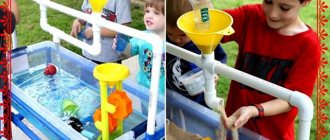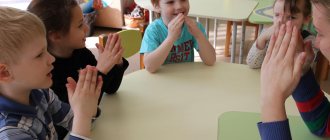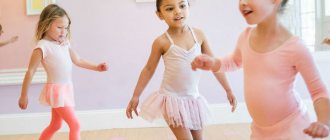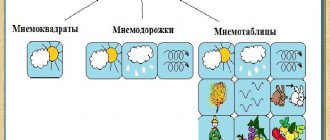Foot massage
The bear walked and walked (we plow our knuckles along the entire length of the foot) He came to the forest. (put a point with your fist) He took a saw and sawed, sawed, sawed (the entire surface of the foot was rubbed with the edge of his palm) He took an ax and chopped, chopped, chopped (again, the chopping movements were imitated with the edge of his palm) He took a hammer and hammered in nails (the fist imitated the movements of hammering nails) I straightened the leaves (massaging my fingers, each separately) I took a brush and painted it (affectionate stroking) Oh, what a great fellow! A wonderful craftsman! (kiss on the heel, the child is delighted, although, apparently, a little ticklish) *** Wall-wall (cheeks tickle) Ceiling (forehead tickled) Two steps (stepping movements of fingers on the chin and lips) Dziiin! Ring! (press the nose as if it were a bell button)
We recommend reading: Why doesn’t a month-old baby sleep all day - what to do?
Swift:
And here’s another fun thing: I put the child on my lap and ask - Is the accordion player at home? (The child answers or waves his head “at home-at home”) - Is the accordion ready? (Ready!) - Can I play? (Here are the options: “Yes” - I’m playing , I tickle the ribs, “No!” - “Well, I’ll come later,” and all over again. The “no!” option is extremely rare, the son wants to be tickled)
streKozuchka:
There is also a facial massage: forest - we run it through the hair, a clearing - along the forehead, a hillock - we run it along the nose, a hole - the child opens his mouth and finger “Am!” Tancha:
... and continuation: down the chin - “cliff”, pry the chin from below with your finger so that the mouth slams shut - “explosion” (well, carefully, of course, without extremes)
Bear massage, agricultural
A bear was walking. A big bear (we stomp on the back with our palms) A bear walked... (we stomp on a smaller area, with our fist, for example) A small bear cub walked (we walk along our back with our fingers) They found a large field (we rub our back with our palms). The bear said: “My-e-e field” (we speak in a deep voice, run in circles with our palms on the back) The bear said: “My-e-e field” (in a higher voice and smaller steps) The bear cub shouted “Mine” (in a thin voice, in small jumps ) They thought and decided that the field would be common. There's enough for everyone. And they decided to plant wheat. We plowed the field (we make some digging movements from the bottom up along the back, then down), leveled it (rubbed it with our palms) and planted the grains (knock lightly with the ends of our fingers all over the back). The rain poured on the grains (we move the back of our fingers in waves along the back), the sun warmed us, and the wheat has sprouted... Large and beautiful ears have grown... The time has come and they began to reap the wheat (with our left hand we take a fold of skin, as if pinching, we cut it with the right edge of our palm) They collected all the wheat into sheaves, there were a lot of sheaves (with the bottom of our fist we put tight marks on the back) Hooray! Hooray! Hurray! (in different voices) Oh, how much wheat we have grown, what a harvest! The bears rejoiced. We collected all the sheaves on a cart and took them to the mill. The horse took the wheat to the mill (we gallop along the back with four hooves) What was left was a clean, clean field (we stroke the back with our palms in a circular motion) And the bears ground the wheat grains - it turned out to be flour. They brought the flour home and baked a delicious one -delicious bread...
Rails, rails...
Rails, rails (we draw one, then another line along the spine) Sleepers, sleepers (we draw transverse lines) A late train was traveling (“we are riding” with our palm on the back) Peas suddenly fell out of the last window (we hit the back with the fingers of both hands) The chickens came and pecked (knock with index fingers) The geese came and nibbled (we pinch the back) The fox came, (we stroke the back) Wagged its tail An elephant passed, (“we walk” along the back with the back of our fists) A female elephant passed, (“we walk” with our fists, but with less effort) Passed little elephant. (“let’s go” with three fingers folded together) The store director came, (“let’s go” along the back with two fingers) Smoothed everything out, cleared everything out. (we stroke our back with our palms up and down) We set up a table, (we depict a table with a fist) A chair, (a chair with a pinch) A typewriter. (typewriter - with a finger) He began to type: (“we type” on the back with our fingers) To my wife and daughter, Ding-dot. (with these words we tickle the side every time) I’m sending you stockings, Ding-dot. Read, (move your finger as if reading) Wrinkled, smoothed, (pinch and then stroke the back) Read, Wrinkled, smoothed, Folded, Sent. (“put the letter” behind the collar)
Using children's self-massage in physical education classes
When choosing health-saving technologies for working with children, based on medical indications, age characteristics and diagnostics of the physical development of children, I came to the conclusion that play self-massage is quite appropriate in the water and final part of physical education classes, as well as between performing certain basic movements to relieve tension. Self-massage allows you to enhance the effect of practicing positive emotions, arouse interest in taking care of personal health, and form the habit of a healthy lifestyle. It is important to teach children to perform massaging movements gently, effortlessly, lightly stroking, or lightly pressing on parts of the body, in the direction from the periphery to the center.
Massage techniques
- pressing
- stroking
- tapping
- kneading
- trituration
- topping
Expected results of massage
Educational direction
- mastering the rules of self-massage
- mastery of the simplest self-massage techniques
Wellness direction
- improved blood circulation
- improvement of metabolic processes
- strengthening the arch of the foot
- positive effect on the central nervous system
Educational direction
- encouragement of activity
- development of creative abilities
- development of positive emotions
The simplest types of self-massage
Foot massage
- clenching and unclenching of toes
- walking on massage mats
- walking along ribbed paths
- walking on toes, on heels
Massage of fingers and palms
- stretching each finger with light pressure
- lightly rubbing each finger without twisting (as if putting on a ring)
- various finger gymnastics
- rubbing the palms
- clapping hands
Hand massage
- stroking the arms from the hands to the shoulders
- tapping hands from hands to shoulders
- rubbing the forearms
Foot massage
- stroking from foot to thigh
- patting from foot to thigh
Back massage
- using a gymnastic stick
- using friendly help
Body massage
- side pinching
- stroking the abdomen with light circular movements clockwise
- stroking the center line of the chest with movements from bottom to top
Head massage
- stroking the head with hands from top to bottom
! Facial massage during physical education classes is unacceptable, as children’s hands may not be clean.





